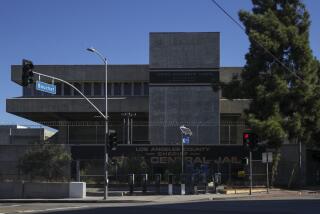Fragile Artifacts at Hearst Castle Survive Quake
Seconds after the ground began trembling last week, three thoughts raced through Hoyt Fields’ mind: Was his family all right? Were his employees and visitors safe? How many artifacts were being destroyed?
The museum curator at Hearst Castle was relieved to learn later that everyone at home and work was safe after the 6.5 temblor that struck the Central Coast.
That left the thousands of fragile artifacts that he is responsible for at the castle. To his surprise, they came out of the quake in relatively good shape as well. Of 22,500 sculptures, columns, vases and works of art at the popular tourist destination, only 12 toppled and broke -- all of them repairable.
“I was looking at seeing quite a bit of damage. But I was totally in awe,” Fields said.
Despite being only a few miles from the epicenter of the quake, Hearst Castle escaped serious damage. The former home of publishing baron William Randolph Hearst, the castle is a 165-room estate of reinforced steel and concrete, built on the bedrock of the pastoral Santa Lucia Mountains.
Its architect, Julia Morgan, had seismic considerations in mind when she designed it in 1919; she had lived through the San Francisco earthquake of 1906.
Morgan’s attention to seismic protection, Fields believes, helped keep the castle secure while other historic structures in San Luis Obispo County collapsed or suffered major damage.
Though many artifacts are secured by brackets and what Fields called “specially formulated quake wax,” a dozen free-standing pieces hit the ground.
These were the unlucky 12:
* A decorative stone garden urn from 18th century Italy that toppled and shattered on the castle’s South Esplanade walkway. It was the only one of the four outdoor urns to be damaged.
* In the main library, a pear-shaped Persian white marble vase sitting atop a hexagonal table that “jumped right off,” Fields said. The 1st century BC vase, which Fields said weighed “as much as my 19-month-old grandson,” broke into several large pieces.
* Three Persian pottery vases, each with a dark, iridescent turquoise glaze. One fell off a Spanish traveling chest, the other two from a fireplace mantel.
* In the six-bedroom Casa Del Mar building, three of four 19th century Italian decorative columns that tumbled in the open atrium. They had carvings of religious figures, with birds on the corners and flowers at the base.
* A 3-foot tall painted stone sculpture of St. Barbara, from 15th century France, that fell off a mantel and broke in three pieces in the Gothic Study room.
* And three carved wooden statues. Paint was chipped on a statue of St. Martin; statues of St. John and St. Catherine each lost a hand.
It was the first time in Fields’ 34 years at the museum that items had been damaged in a quake.
Repairing them is expected to cost thousands of dollars, though he said the artifacts’ actual value is substantially more.
Fields won’t say how much, for security reasons.
Officials hope to have all 12 artifacts restored by 2006.
“Someone asked me what one item I would grab” in a disaster, Fields said. “They’re all irreplaceable. Anything you grab is the most valuable piece in the room.”
More to Read
Sign up for Essential California
The most important California stories and recommendations in your inbox every morning.
You may occasionally receive promotional content from the Los Angeles Times.










